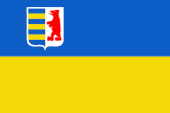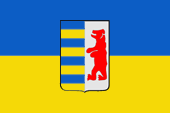Karpato-Ukraine |
|
|
|
| Übersicht – Contents: | |
Karpato-Ukraine |
|
|
|
| Übersicht – Contents: | |
Flaggen – Flags: |
|
 |
Flagge des ukrainischen Oblasts Traskarpatien |
 |
bis/to 1939, |
| Transkarpatien ist seit 1945 ein Teil der Ukraine und bildet einen eigenen Bezirk. Dieser nahm am 27.02.2009 eine eigene Flagge an, die der historischen Flagge Transkarpatiens ähnelt. Die Flagge zeigt die Farben der Ukraine und im blauen Streifen am Mast das Wappen von Transkarpatien, jedoch nicht ganz so wie es von diesem Landesteil verwendet wurde, als es ein Teil der Tschechoslowakei war (1918–1939). Diese historische Flagge ist inoffiziell. Sie wird von den in Polen und der Slowakei lebenden Ruthenen verwendet. Ruthenen sind Ukrainer, die außerhalb der Ukraine leben. In den Karpaten werden sie auch Russinen, Huzulen, Lemken, oder Bojken bezeichnet. | Transcarpathia is since 1945 a part of the Ukraine and it is an own distrikt there. That adoped an own flag on 27th of February in 2009, which is nearly similar to the historic flag of Transcarpathia. The flag shows the colours of Ukraine and in the blue stripe the coat of arms of Transcarpathia near the pole, but not exactly in the same style how it was used from this country as it was a part of Czechoslovakia (1918–1939). That historic flag is unofficial. It is used by the in Poland and in Slovakia living Ruthenians. Ruthenians are Ukrainians, which live outside the Ukraine. In the Carpatia Mountains they are called Russins, Huzuls, Lemkes, or Bojks too. |
|
Quelle/Source: Flags of the World, Volker Preuß |
|
Wappen – Coat of Arms: |
|
 |
historisches Wappen Transkarpatiens – historical coat of arms of Transcarpathia, Quelle/Source: Flags of the World |
| Das Wappen Transkarpatiens stammt mindestens aus dem Jahr 1918, als dieses Gebiet von Ungarn an die Tschechoslowakei überging, denn seine Heraldik tauchte im Staatswappen der Tschechoslowakei als Repräsentant Transkarpatiens auf, und wurde bis zur Rückgabe an Ungarn 1939 verwendet. | The coat of arms of Transcarpathia originate leastways from the year 1918 as this region was transfered from Hungary to Czechoslovakia, because its heraldry arised in the coat of arms of Czechoslovakia as representative of Transcarpathia and was in use there until the return to Hungary in the year 1939. |
| Das Wappen ist längs gespalten und zeigt im linken Feld die ukrainischen Farben Blau und Gold in vierfacher Wiederholung, wenn auch in heraldisch falscher Reihenfolge. Im rechten Feld ein stilisierter roter Bär auf silbernem Grund. Seine Herkunft und Bedeutung sind ungeklärt, vielleicht steht er für die Kapaten. | The coat of arms is lengthwise divided and shows in the left field the Ukrainian colours blue and gold in fourfold duplication, but however in heraldic wrong succession. In the right field a stylized red bear on silvery ground. Its origin and meaning are unsolved, possibly it stands for the Capatia Mountains. |
| Quelle/Source: Flags of the World | |
| Zahlen und Fakten – Numbers and Facts: | |
|
|
|
|
|
|
|
|
|
|
|
|
|
|
|
|
|
|
|
|
10. Jhd.
· das Gebiet des heutigen Transkarpatiens - von ostslawischen Stämmen
(Vorfahren der Ukrainer) besiedelt - kommt an Ungarn 1541 · der ungarische König Johann Siegmund ruft die Türken ins Land, das Gebiet des heutigen Transkarpatiens wird Siebenbürgen angegliedert, Siebenbürgen wird vom Osmanischen Reich abhängig 1688 · der Landtag von Siebenbürgen anerkennt die Oberhoheit des ungarischen Königs und des Römisch-Deutschen Kaisers 1697 · Schlacht von Karlowitz, das Osmanische Reich verliert Ungarn, Slavonien, Kroatien und das Fürstentum Siebenbürgen (und damit Transkarpatien) an das Reich der Österreichischen Habsburger März bis November 1848 · Revolution in Wien, Bürgerkrieg zwischen Ungarn und Kroaten, Aufstände in Prag, Mailand und Venedig, daraufhin dankt Kaiser Ferdinand I. ab und Franz Joseph I. von Habsburg wird neuer Kaiser, neue Verfassung, Ende der monarchischen Untergliederung des Landes und anstelle dessen Einrichtung von Kronländern mit eigenen Parlamenten, Transkarpatien kommt an Ungarn, die Aufstände werden niedergeschlagen 08.02.1867 · Österreichisch-Ungarischer Ausgleich, gleiches Recht für beide Landesteile, Entstehung der Doppelmonarchie Österreich-Ungarn, Österreich: bestehend aus den österreichischen Kronländern, Ungarn: bestehend aus Ungarn selbst und seinen Nebenländern, das Haus Habsburg stellt in einer Person den Kaiser von Österreich und den König von Ungarn, Einrichtung von gemeinsamen Ministerien in Außenpolitik, Finanzen und Verteidigung 28.06.1914 · Ermordung des österreichischen Thronfolgers Franz Ferdinand und seiner Frau, Beginn des Ersten Weltkriegs (1914–1918) 28.10.1918 · die Tschechoslowakei spaltet sich von Österreich-Ungarn ab, Anschluss Transkarpatiens an die Tschechoslowakei 14.03.1939 · die Slowakei spaltet sich von der Tschechei ab, Ende der Tschechoslowakei, Ungarn annektiert Transkarpatien, Polen das Gebiet um Teschen 1939–1945 · Zweiter Weltkrieg: 1944 · Transkarpatien wird von sowjetischen Truppen besetzt und wenig später von der Sowjetunion annektiert (Angliederung an die Sowjetukraine) |
|
10th cent.
· the region of the today’s Transcarpathia - settled by Eastern Slavonic
tribes (ancestors of the Ukrainians - comes to Hungary 1541 · Johann Siegmund calls out for the Turks, Transylvania (Siebenburgen) becomes dependent from the Ottoman Empire 1688 · the parliament of Siebenburgen recognizes the supremacy of the Hungarian king and the Roman-German emperor 1697 · Battle of Karlowitz, the Turks have to cede Hungary, Slavonia, Croatia and the Principality of Siebenbuergen (and in this way the Carpato Ukraine) to the Empire of the Austrian Habsburgs March to November 1848 · revolution in Vienna, civil war between Hungarians and Croats, riotings in Prague, Mailand and Venice, as a result of that resigns Emperor Ferdinand I. and Franz Joseph I. of Habsburg becomes new Emperor, new constitution, end of the monarchical subdivisions of the country and instead of this establishment of crown lands with own parliaments, Transcarpathia comes to Hungary, the riotings become suppressed 8th of February 1867 · Austrian-Hungarian conciliation, equal right for both parts of the country, nascence of the double monarchy of Austria-Hungary, Austria: consisting of the Austrian crown lands, Hungary: consisting of Hungary itself and its minor countries, the House of Habsburg sets in one person the Emperor of Austria and the King of Hungary, establishment of common ministries in foreign affairs, finance and defense 28th of June 1914 · assassination of the Austrian throne successor Franz Ferdinand and of his wife, onset of the First World War (1914–1918) 28th of October 1918 · the Czechoslovakia separates from Austria-Hungary, annexation of Transcarpathia by Czechoslovakia 14th of March 1939 · Slovakia separates from Czechia ab, end of Czechoslovakia, Hungary annexes Transcarpathia, Poland the region around the City of Teshen 1939–1945 · Second World War: 1944 · Transcarpathia becomes occupied by soviet troops and a little later annexedby the Soviet Union (affiliation to the Soviet Ukraine) |
| Quelle/Source: Wikipedia (D) |
| Der Name "Karpato-Ukraine" verdeutlicht die Lage des Landes am Karpaten-Gebirge und auch seine politische Zugehörigkeit, zumindest jedoch die Nationalität der meisten seiner Bewohner. | The name "Carpato Ukraine" expresses the position of the country at the Carpatia Mountains and also its political affiliation, but at least the nationality of the most of its inhabitants. |
| Der Begriff "Transkarpatien" beschreibt die Lage des Landes "auf der anderen Seite der Karpaten", vom Norden, von der Ukraine aus gesehen. | The word "Transcarpathia" describes the situation of the country "at the other side of the Carpatia Mountains", seen from the north, from the Ukraine. |
| Die hier lebenden Ruthenen sind Ukrainer, die sonst außerhalb der Ukraine leben. In den Karpaten werden sie auch als Russinen, Huzulen, Lemken, oder Bojken bezeichnet. | The here living Ruthenians are Ukrainians which otherwise live outside the Ukraine. In the Carpatia Mountains they are also called Russins, Huzuls, Lemkes, or Bojks. |
| Quelle/Source: Die Völker der Erde, Volker Preuß | |